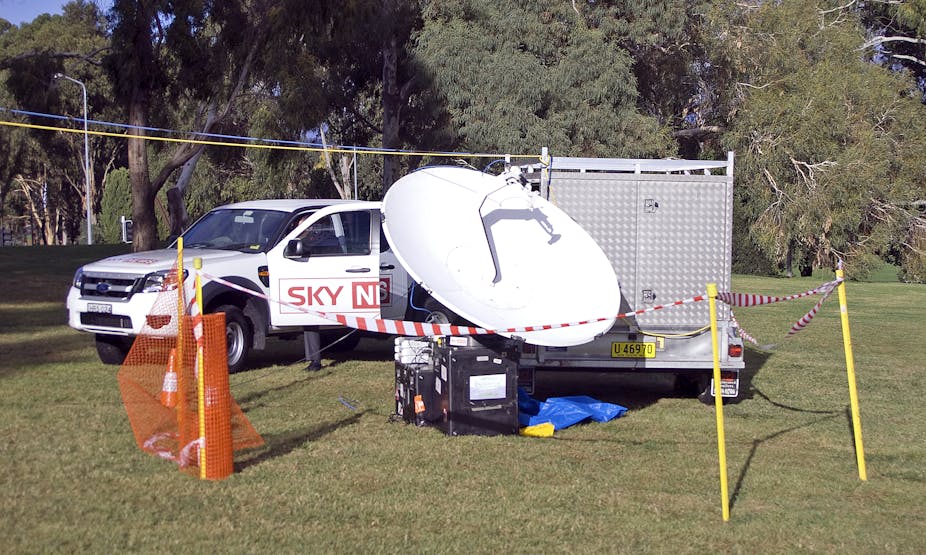If national news headlines are anything to go by, Australia’s regional media are in peril and the big moguls are powerless to save it unless they are cut free from debilitating red tape. However, some of the bush tales about regional news that are circulating need to be debunked.
Prime Media Group, WIN Television and Southern Cross Austereo are threatening to cut local news services unless the “reach rule” – which prevents a television network being able to reach more than 75% of the population – is removed. They also challenge the Broadcasting Services Act as amended in 2006, which allows media companies to own up to two media outlets in a single area. To them, it is perhaps better to let one media company invest in a regional area than leave a community without any media coverage at all.
Other big players, Seven West Media and News Corporation, strongly oppose that idea. Instead, they suggest reducing broadcasting licence fees to support re-investment in local content. They argue the campaign by their regional counterparts is nothing more than scaremongering and the government should not be fooled by these self-interested demands.
Prime Minister Tony Abbott has said the big media players should thrash out a deal among themselves. There has been some intense debate, but industry consensus seems unlikely.
The parliamentary secretary to the communications minister, Paul Fletcher, acknowledges that regional broadcasters are under economic pressure. He says rural and regional MPs who support reform are right to be concerned about how government can create more breathing space to help a struggling regional media sector survive.
However, our research suggests all parties need to step back from a tight focus on what parts of the industry want. They need instead to consider what policy settings can best serve the news and information needs of rural and regional Australians in a shifting media environment.
Three myths about regional media
Our contribution to the conversation about media policy for regional Australia is to debunk three myths that are circulating as part of the debate. We also warn stakeholders to be wary of those purporting to be the saviours of bush media when they stand to line their own pockets at the expense of the greater good.
The first myth is that geographic boundaries no longer matter in discussions about media ownership and the reach rule. The argument, as put forward by Prime chairman John Hartigan among others, is that the reach rule becomes redundant in digital spaces. Meanwhile, Deputy Prime Minister Warren Truss said this week:
Geographical boundaries are less important as media consumers obtain their entertainment and news on demand from multiple sources from around Australia and around the world. Our primary concern is that local news and local stories must continue to be broadcast in regional licence areas.

Our research contends that while local media is now part of global digital information flows and systems, geography still matters. Physical borders may have been smashed in terms of transmission and dissemination of news, but geography remains king in terms of content. The question on policymakers’ minds should be whether loosening media restrictions will mean a greater emphasis on and improved quality of local news in all corners of the country, rather than a “better something than nothing” approach.
The second myth is that without changes to media ownership laws, local media may suffer a slow and painful death. A top-down approach to media policy throws out the economy of scale. Local news is part of our culture and, if done well, is seen as central to ideas of community.
This symbolic power exists in large-scale commercial form where it is particularly influential, but it is also generated at grassroots level where new online hyperlocal outlets are emerging. Even small local newsletters serve as valuable sources of information for communities, but often escape our attention. Further research is needed into how local media are faring, what forms these media take across regional Australia and where issues of media plurality are greatest.
The third myth is that there are inequities between metropolitan and rural/regional news audiences. Again, Hartigan has argued that Australia’s media rules are out of date due to the impact of the internet. He says it is an issue of equity, advancing the idea that people in cities have an advantage in news and information.

Our research suggests, however, that people with internet access in regional areas have access to a greater variety of news than they ever had before.
The abundance of international and national news made available through digital platforms has created a media market demanding more local content, according to Seven West Media chief Tim Worner. Our research on regional news media supports the view that media providers need to focus on the “marketplace of niche”. There remains money to be made, but arguably the profits must now be shared among a variety of players.
The federal government should encourage and promote potential for diversity, at least for the time being, rather than be quick to reinforce existing power structures. We need to know more about what we mean by “local” news in the digital world, question whether traditional legacy media providers are the saviours and, if so, ensure they inform and give strong voice to regional communities.

